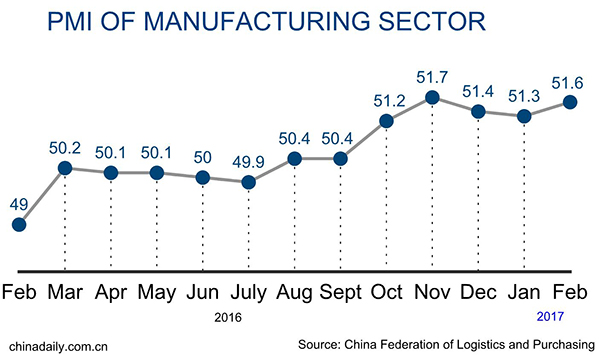China's manufacturing activity expands for 7th month

BEIJING - China's manufacturing sector expanded for the seventh month in a row, evidence that the world's second largest economy is stabilizing amid an uncertain global outlook.
The country's manufacturing purchasing managers' index (PMI) came in at 51.6 in February, 0.3 points higher than that recorded in January, according to National Bureau of Statistics (NBS) data released Wednesday.
A reading above 50 indicates expansion, while a reading below reflects contraction.
NBS statistician Zhao Qinghe said February's reading remained above 51 for five months in a row and pointed to steady expansion of the manufacturing sector.
The latest reading showed the economy's recent stabilization would continue, said Zhang Liqun, a researcher with the Development Research Center under the State Council.
The Chinese economy started the year strongly, with key economic indicators, including those for trade and inflation, all rebounding.
The country's trade started the year with a strong rebound, with exports and imports both up significantly, despite rising trade protectionism, sluggish overseas demand and increasing domestic production costs.
Meanwhile, China's producer prices rose faster than expected in January while consumer inflation increased, reinforcing views that economic growth is firming.
The sub-index for production was 53.7, 0.6 points higher than that recorded in January.
The sub-index for new orders was up 0.2 points to 53.
Zhao attributed the acceleration of production and new orders to the recovery in market demand and robust production.
In addition, the sub-index for the equipment manufacturing sector expanded to a three-year high of 53.3, 1.7 points higher than the overall manufacturing industry.
Chen Zhongtao, an analyst at the China Logistics Information Center, said positive factors had grown for the Chinese economy, including increasing demand, rising prices, better performance of companies, restructuring and a good job market.
The NBS data showed that the sub index for production and business activities expectation rose for the second month to 60 in February, which indicates enterprises are optimistic about the future.
The Chinese leadership on Tuesday stressed quality in reviving the manufacturing sector, saying the sector should shift from increasing quantity to improving quality.
They said that more energy would be channeled into reducing prices and administrative fees in monopolized sectors as well as lowering business burdens.
A separate survey of the service sector also showed steady growth, with non-manufacturing PMI down 0.4 points to 54.2, but staying above the boom or bust 50-mark for the fifth straight month, according to the NBS.
Railway transport, telecommunication and satellite transmission service, Internet and software information technology, finance and insurance were among the fastest growing service sectors, while retail, road transport, catering and property reported contractions.
The service sector accounted for more than half of China's economy last year and for the majority of growth, as rising income made catering, hotels and travel services more affordable for Chinese consumers.
Cai Jin, deputy head of China Federation of Logistics and Purchasing, said the non-manufacturing PMI pointed to a stable and booming non-manufacturing sector.
China reported 6.7 percent GDP growth in 2016, lower than in recent years but within the government target range.

















